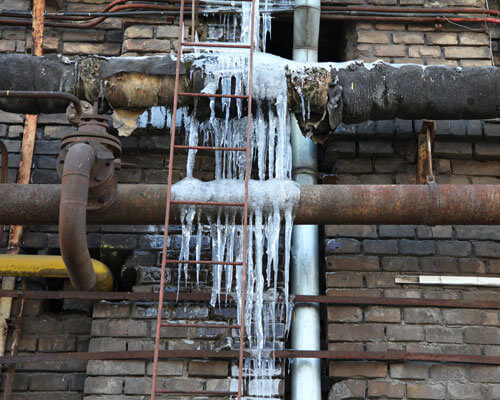The Air Conditioner Pipe Is Frozen - What Do I Do? Guidance for Homeowners
The Air Conditioner Pipe Is Frozen - What Do I Do? Guidance for Homeowners
Blog Article
Presented here down the page you will discover additional brilliant details involving Have a Frozen AC Line? Here’s How to Fix It.

Introduction
Discovering that your AC pipeline is frozen can be worrying, particularly during hot summertime when you count on your a/c unit the most. Understanding what to do in such a circumstance is essential to stop further damage to your air conditioning system and guarantee your comfort inside your home.
Comprehending the Causes
A number of factors can contribute to the cold of an air conditioner pipeline. Recognizing these reasons can help you deal with the issue efficiently.
Lack of Airflow
One typical root cause of an icy air conditioning pipe is inadequate airflow. When the air flow over the evaporator coil is restricted, it can create the coil to go down below freezing temperature level, causing ice formation on the pipe.
Reduced Refrigerant Levels
Inadequate refrigerant levels in your air conditioner system can also result in an icy pipe. Low cooling agent levels can create the pressure in the system to drop, bring about the freezing of dampness on the evaporator coil.
Winter Conditions
In chillier environments, freezing temperature levels outside can contribute to the freezing of air conditioner pipes. If your AC device is not correctly protected or if there are leaks in the ductwork, cool air can infiltrate the system, creating the pipeline to freeze.
Dirty Air Filters
Filthy or clogged air filters can limit airflow in your air conditioning system, leading to various issues, consisting of a frozen pipeline. It's necessary to change or clean your air filterings system consistently to guarantee correct airflow and avoid ice build-up.
Signs of a Frozen Air Conditioning Pipe
Identifying the indicators of an icy air conditioner pipe is important for timely activity.
Lowered Airflow
If you notice a significant decrease in air flow from your vents, it might suggest an icy pipeline.
Ice Buildup on the Pipe
Visible ice accumulation on the refrigerant line or the evaporator coil is a clear indication of a frozen AC pipe.
Unusual Sounds from the Unit
Unusual sounds, such as hissing or gurgling, originating from your air conditioning system can signify that there's ice existing on the pipe.
Immediate Actions to Take
When faced with an icy air conditioner pipe, it's important to act rapidly to prevent more damage to your air conditioning system.
Switching off the air conditioner
The first step is to switch off your air conditioner to avoid the system from running and intensifying the concern.
Checking for Blockages
Check the area around the indoor device for any blockages that may be obstructing air movement, such as furniture or curtains.
Defrosting the Pipe
You can make use of gentle techniques like placing towels soaked in warm water around the frozen pipeline to aid thaw it gradually.
Preventive Measures
Taking preventive measures can assist prevent future incidents of a frozen AC pipe.
Regular Maintenance Checks
Schedule regular maintenance talk to an expert HVAC service technician to make certain that your a/c system is running efficiently.
Transforming Air Filters
Regularly change or cleanse your air filters to avoid airflow restrictions and keep ideal performance.
Shielding Exposed Pipes
If your air conditioner pipelines are exposed to cool temperature levels, consider shielding them to avoid cold throughout winter months.
Looking For Professional Help
If DIY approaches fail to settle the problem or if you're unsure regarding just how to proceed, it's finest to look for assistance from a certified HVAC specialist.
When DIY Methods Fail
If your attempts to thaw the pipeline or address various other problems are not successful, it's time to contact a specialist.
Importance of Hiring a Professional HVAC Technician
A licensed HVAC professional has the knowledge and devices needed to detect and repair problems with your air conditioning system safely and efficiently.
Verdict
Dealing with a frozen air conditioning pipe can be an aggravating experience, yet recognizing exactly how to respond can assist lessen damage and restore convenience to your home. By recognizing the causes, identifying the indicators, and taking timely action, you can properly resolve the concern and avoid future occurrences.
What to Do If Your AC Line Is Frozen
Make Sure All Supply and Return Air Vents Are Open
If you notice problems with airflow, the first thing you should do is check your supply and return vents. Supply vents distribute clean, conditioned air throughout your home. As this air becomes stale, it’s pulled into the return vent, where it’s reconditioned before being sent back out through the supply vent.
When these vents are closed, air won’t flow in the home. Before examining your AC, check the vents in every room and ensure they’re all open.
Check for a Dirty Air Filter
Another possible cause of limited airflow is a dirty air filter. Your air conditioner’s filters catch elements you don’t want to breathe in, such as dirt and dust. Over time, filters can become clogged, ultimately blocking air from flowing in and out. The lack of airflow can then cause the entire coil to freeze and will completely restrict any air from moving through it. The AC may need to be powered off for one to two days to allow the coil to thaw after replacing the filter to allow proper functioning of the unit. This debris can also accumulate on your AC’s evaporator coil, requiring a more serious repair. In general, air filters should be cleaned regularly (about every two weeks).
Assess Your Outdoor Unit
In addition to checking your AC, assessing the outdoor unit is a good idea. Also known as the condensing unit, it works with your interior unit to release heat outside. An issue with the outdoor unit can result in rising internal temperatures.
Overgrown Shrubs or Clogged Leaves
From leaves and twigs to shrubs and debris, there’s no shortage of outdoor elements that can accumulate around your condensing unit. When these elements get lodged inside the unit, they can block airflow. Fortunately, removing the blockage can solve the problem.
Sounds of a Broken Fan
Shrubs and leaves aren’t the only things that can impede your outdoor unit’s airflow. If the fan is broken, the unit won’t be able to properly get rid of heat — which means the internal temperature won’t go down. First, make sure the fan is spinning. If it is, check for the following sounds of a broken fan:
Buzzing Rattling Screeching Hissing Clicking Preventative Measures
Nobody wants to deal with a frozen AC line. In addition to causing problems with your air conditioner, they require professional repairs. On the bright side, there are preventative measures you can take to help ensure this issue doesn’t arise in the first place.
https://www.coopergreenteam.com/blog/what-to-do-if-ac-line-frozen

We hope you enjoyed reading our part about How can I fix an air conditioner’s frozen pipe?. Thank you so much for taking time to browse our article. Be sure to take the time to distribute this article if you appreciated it. Thank-you for going through it.
Estimate Free Report this page